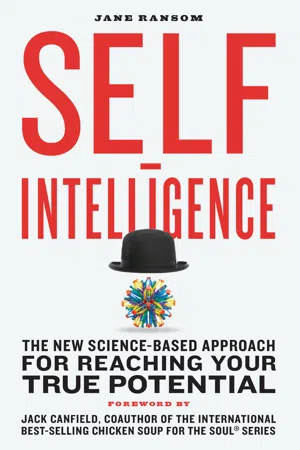
Self-Intelligence
The New Science-Based Approach for Reaching Your True Potential
- 288 pages
- English
- ePUB (mobile friendly)
- Available on iOS & Android
About This Book
"If you are reading this, count yourself lucky to have found this book. It contains some of the most fascinating information and material you will ever read." — New York Times best-selling author Jack Canfield Self-Intelligence is the self-help book for people who long to transform their lives and who trust only proven scientific tools, but also prefer page-turners to dry prose. Cutting-edge brain science meets superb storytelling as readers learn proven techniques to break through inner gridlock, sustain high performance, and achieve their dreams. All of this is possible due to neuroplasticity, the revolutionary discovery that we can literally re-form our brains by strategically choosing our thoughts, actions, and experiences. First came emotional intelligence, then came social intelligence. Here, at last, Self-Intelligence provides the big picture, incorporating the latest research from diverse scientific fields. Mental coach, transformational trainer, and science addict Jane Ransom lays out for you the new Self-Intelligence ™ model, which she has used to help countless clients achieve the positive change they previously found impossible. You'll be uplifted, motivated to move forward, and simply fascinated. The author, who also is a master hypnotist, devotes a riveting chapter to the art and science of hypnosis. Throughout the book, she shares intriguing behind-the-curtain glimpses of its applications. By following the easy, clear precepts of Self-Intelligence, you can finally achieve your true potential and take the scientific short-cuts to greater success. You'll be empowered to avert old obstacles because the five-part model addresses your entire being, from the hidden depths of your subconscious self to your striving self, who sets and achieves tangible goals.
Frequently asked questions
Information
PART ONE
PROGRAMMING YOUR SUBCONSCIOUS SELF

CHAPTER 1
DREAMS
Thinking Through Dreaming
Table of contents
- Cover
- Title Page
- Dedication
- Contents
- Foreword
- Introduction | Welcome to the Party!
- Part One | Programming Your Subconscious Self
- Part Two | Conditioning Your Conscious Self
- Part Three | Thinking Through Your Embodied Self
- Part Four | Integrating Your Social Self
- Part Five | Vitalizing Your Striving Self
- Conclusion | Party On
- Chapter Summaries
- References
- Acknowledgments
- About the Author
- Index
- Copyright